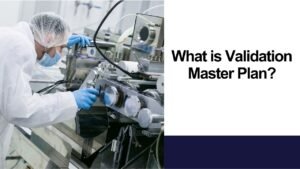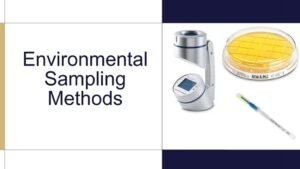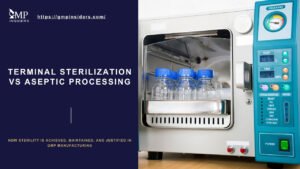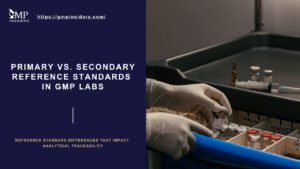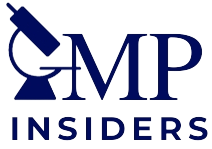Cleanrooms are an integral part of pharmaceutical and medical product manufacturing. They provide tightly controlled environments that reduce the risk of contamination from airborne particles and microorganisms.
Regulatory authorities worldwide have established detailed guidelines for cleanroom classification and control to maintain the highest product quality and patient safety standards.
This article explores the framework of GMP cleanroom classifications, examining the key differences between Grades A to D, their ISO 14644-1 equivalents, specific applications, and the environmental and microbial monitoring requirements essential for maintaining compliance.
Introduction to GMP Cleanroom Classifications
Good Manufacturing Practice (GMP) guidelines for pharmaceutical cleanrooms were established to ensure product safety, purity, and efficacy. These guidelines are designed to minimize the risk of contamination from particulates, microorganisms, and pyrogens during sterile manufacturing processes such as preparation, filling, and packaging.
GMP cleanroom requirements are comprehensive, ranging from facility design and environmental controls to personnel behavior, gowning, and cleaning procedures. One of these requirements is the cleanroom classification system, a structured method for defining cleanliness levels based on airborne particulate concentration and microbial control.
Two major standards form the basis for pharmaceutical cleanroom classification:
- ISO 14644-1, which defines cleanroom classes (ISO Class 5 to ISO Class 9) based solely on airborne particle concentrations.
- EU GMP Annex 1 (Grade A, B, C, D), which applies ISO principles to pharmaceutical environments and introduces additional microbial limits, gowning expectations, and operational state distinctions (“at rest” and “in operation”).
GMP Cleanroom Classes and ISO Equivalents
GMP cleanrooms are categorized into four grades—Grade A, B, C, and D—based on the criticality of operations performed within each area. These grades correlate with ISO classes, providing a harmonized reference for particle limits.
Grade A Cleanroom
Grade A is reserved for the most critical operations, such as aseptic filling, compounding, and open handling of sterile products.
- ISO Equivalent: ISO Class 5 (both at rest and in operation)
- Particle Limit: ≤ 3,520 particles ≥ 0.5 µm/m³
Related Article: ISO Class 5 Cleanroom Requirements
Grade B Cleanroom
Grade B areas serve as the background environment for Grade A zones and support aseptic processing.
- ISO Equivalent: ISO Class 5 (at rest), ISO Class 7 (in operation)
- Particle Limits:
- At rest: ≤ 3,520 particles ≥ 0.5 µm/m³
- In operation: ≤ 352,000 particles ≥ 0.5 µm/m³
Grade C Cleanroom
Grade C cleanrooms are used for less critical stages, such as preparing solutions and handling components before sterilization.
- ISO Equivalent: ISO Class 7 (at rest), ISO Class 8 (in operation)
- Particle Limits: ≤ 352,000 particles ≥ 0.5 µm/m³
Grade D Cleanroom
Grade D areas are designated for the least critical stages of sterile drug production, including initial handling and washing of components.
- ISO Equivalent: ISO Class 8 (at rest and in operation)
- Particle Limit: ≤ 3,520,000 particles ≥ 0.5 µm/m³
RELATED ARTICLE: Cleanroom Classification According to ISO 14644-1
Cleanroom Particle Limits and Operational States
Cleanroom classifications are defined by the maximum allowable concentration of airborne particles, typically ≥ 0.5 µm and ≥ 5.0 µm in size. Regulatory guidance, including Annex 1 and ISO 14644-1, requires classification and routine monitoring for Grades A through C conditions.
For Grade D, only “at rest” limits are predefined; “in operation” limits must be set by the manufacturer based on risk assessment.

“At Rest” State: Establishing Baseline Cleanliness
The “At Rest” state signifies a moment of readiness without active manufacturing operations. All utilities, including the vital Heating, Ventilation, and Air Conditioning (HVAC) system, are installed and operational in this phase.
Equipment is meticulously arranged but not yet set into motion, and notably, no personnel inhabit the room. This state establishes a baseline for cleanliness, offering insights into the environment’s inherent purity without the influence of human activities or equipment operation.
Cleanroom Classification Chart No.1: Total Particle Limits for “At Rest” State
| Cleanroom Class | ≥ 0.5 µm (particles/m³) | ≥ 5 µm (particles/m³) |
|---|---|---|
| A | 3,520 | Not specified (a) |
| B | 3,520 | Not specified (a) |
| C | 352,000 | 2,930 |
| D | 3,520,000 | 29,300 |
(a) Classification including 5µm particles may be considered where indicated by the CCS or historical trends.
“In Operation” State: Real-world Cleanroom Dynamics
Contrasting with the quiescence of the “At Rest” state, the “In Operation” state encapsulates the full spectrum of cleanroom functionality. HVAC is not merely operational but fully engaged, equipment hums in its defined mode, and the cleanroom is bustling with the maximum number of personnel immersed in routine work.
This state reflects real-world manufacturing conditions, considering the dynamic factors introduced by human activities and equipment operations.
Cleanroom Classification Chart No.2: Total Particle Limits for “In Operation” State
| Cleanroom Class | ≥ 0.5 µm (particles/m³) | ≥ 5 µm (particles/m³) |
|---|---|---|
| A | 3,520 | Not specified (a) |
| B | 352,000 | 2,930 |
| C | 3,520,000 | 29,300 |
| D | Not predetermined (b) | Not predetermined (b) |
(a) Classification including 5µm particles may be considered where indicated by the CCS or historical trends.
(b) For grade D, in-operation limits are not predetermined; the manufacturer should establish in-operation limits based on a risk assessment and routine data where applicable.
Microbial Contamination Limits and Monitoring in GMP Cleanrooms
While non-viable particle counts are central to cleanroom classification under ISO 14644-1, viable (microbial) contamination control is equally important in pharmaceutical GMP environments.
Cleanrooms must be monitored for microbial contamination using validated sampling methods and compared against established microbiological limits outlined in EU GMP Annex 1.
Microbial Contamination Limits by Cleanroom Grade
Microbial limits are defined by the number of colony-forming units (CFU) permitted in different sample types across cleanroom grades. These limits serve as alert/action thresholds for environmental monitoring programs and are evaluated during cleanroom qualification and routine monitoring.
Cleanroom Classification Chart No.3: Microbial contamination limits
| Cleanroom Class | Air Sample (CFU/m³) | Settle Plates (CFU/4 hours) | Contact Plates (CFU/plate) |
|---|---|---|---|
| A | No growth | 10 | 5 |
| B | 10 | 50 | 5 |
| C | 100 | 50 | 25 |
| D | 200 | 100 | 50 |
Note: Settle plates and contact plates are typically exposed or applied for defined durations, and limits must be justified based on operational data and contamination control strategies.
Viable Monitoring Methods Used in GMP Cleanrooms
Environmental monitoring programs utilize several methods to detect and trend microbial contamination in air and on surfaces:
1. Active Air Sampling
- Pulls a defined air volume across a nutrient medium (e.g., agar strip).
- Quantifies airborne microorganisms (CFU/m³).
- Required in Grades A and B; recommended in C and D areas.
2. Passive Air Sampling (Settle Plates)
- Petri dishes with growth media exposed to the cleanroom air for 2–4 hours.
- Captures particles that settle by gravity.
- Useful for detecting larger particles and surface contamination risk.
3. Surface Monitoring (Contact Plates and Swabs)
- Contact plates are pressed against surfaces (e.g., walls, equipment) to detect microbial residues.
- Swab samples are used in hard-to-reach areas or irregular surfaces.
- Both methods assess cleaning effectiveness and risk of viable transfer.
4. Personnel Monitoring
- Finger dabs and gown sampling (e.g., sleeve or chest area) with contact plates.
- Helps assess the risk introduced by cleanroom operators, especially in Grades A and B.
Determining Sampling Locations:
The selection of sampling locations is a meticulous process guided by a comprehensive risk assessment. Several factors influence the determination of these locations:
- Room Classification: The designated cleanliness level of different cleanroom areas plays a pivotal role in deciding the intensity and frequency of microbial sampling.
- Air Visualization Studies: Insights gained from airflow visualization studies contribute to identifying areas where microbial contamination is more likely to occur.
- Process and Operations Knowledge: A deep understanding of the manufacturing process and associated operations aids in pinpointing critical areas prone to microbial risks.
Considerations for Effective Sampling
- Risk Assessment Integration: The sampling plan should be intricately woven into a comprehensive risk assessment, ensuring that higher-risk areas receive more thorough scrutiny.
- Real-time Monitoring: In addition to periodic sampling, implementing real-time microbial monitoring systems provides continuous insights into the cleanroom’s cleanliness status.
- Prompt Corrective Actions: Deviations from microbial contamination limits should trigger immediate corrective actions, reinforcing a proactive stance against potential risks.
Applications of GMP Cleanroom Grades
Each GMP cleanroom grade is designed to support specific manufacturing activities based on the criticality of the process and the risk of contamination. Understanding the appropriate use of Grades A, B, C, and D is essential for maintaining compliance with Annex 1 and ensuring product safety in pharmaceutical production.
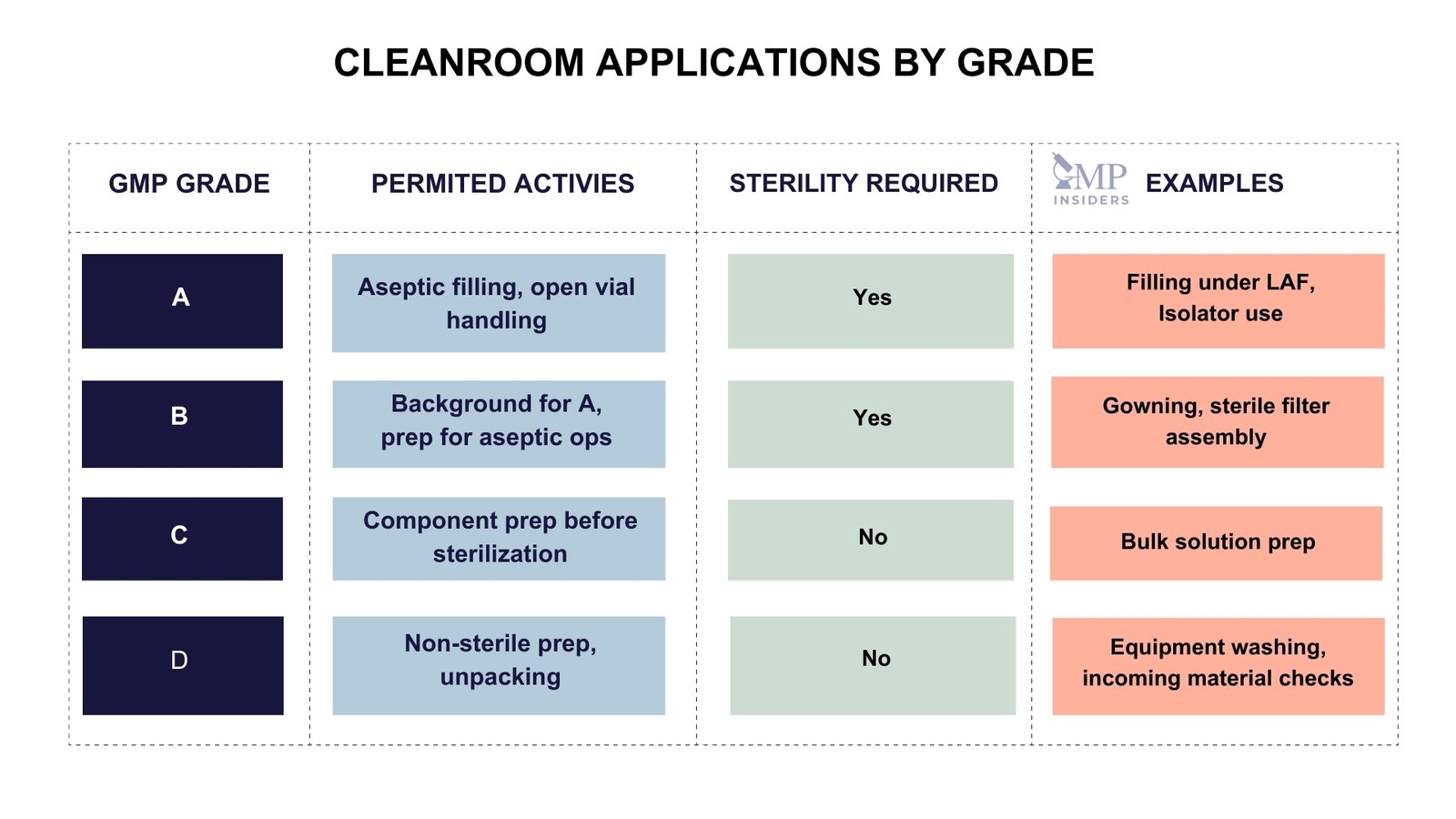
Grade A Cleanroom Applications
Grade A areas provide the highest level of contamination control and are used for critical aseptic operations. These zones require unidirectional airflow (e.g., laminar air flow cabinets or isolators) and are typically maintained under positive pressure with strict particulate and microbial limits.
Common use cases include:
- Aseptic filling of sterile products
- Aseptic compounding and mixing
- Loading and unloading of sterilizers (e.g., autoclaves or lyophilizers)
- Replenishment of sterile bulk, containers, or closures
- Staging of sterile primary packaging materials
- Assembly of sterile connections for single-use systems
Note: These operations usually occur under ISO Class 5 (Grade A) laminar flow units within a Grade B background.
Grade B Cleanroom Applications
Grade B environments act as the background for Grade A zones, supporting aseptic manufacturing processes. These areas are essential in maintaining product sterility by preventing the ingress of contaminants during material and personnel transfers.
Typical applications:
- Preparation and staging of materials for Grade A processing
- Gowning rooms adjacent to aseptic core areas
- Transfer of sterile equipment into Grade A zones
- Cleaning and sanitization of tools used in aseptic filling
- Assembly of sterile filtration systems before use
Note: Grade B areas are usually maintained at ISO Class 5 at rest and ISO Class 7 in operation.
Grade C Cleanroom Applications
Grade C cleanrooms support less critical but still controlled manufacturing steps. These areas are suitable for operations that involve exposing products or components prior to sterilization and preparing solutions and intermediates.
Common uses include:
- Weighing and dissolving raw materials
- Preparation of bulk solutions to be sterilized
- Filling of products that will undergo terminal sterilization
- Assembly of components for later sterilization
Note: ISO Class 7 at rest, ISO Class 8 in operation. Monitoring is essential but less frequent than in higher-grade areas.
Grade D Cleanroom Applications
Grade D environments are designed for basic cleanroom control, typically for initial or final processing steps after sterilization. While these zones do not require the same degree of cleanliness as higher grades, they still help reduce contamination in adjacent areas.
Key activities:
- Washing and drying of equipment and components
- Initial unpacking and inspection of raw materials
- Final assembly of closed systems prior to sterilization
- Cleaning and storage of reusable tools
- Assembly of sterile connectors under closed conditions
Grade D zones are equivalent to ISO Class 8 and are often entry points into higher-grade areas.
Pharmaceutical Cleanroom Design Considerations
Adhering to GMP cleanroom design principles ensures that all elements—from airflow and filtration to zoning and material finishes—are optimized to minimize contamination risks throughout manufacturing. GMP-compliant cleanrooms must be built and maintained to support risk-based contamination control and maintain a consistent control state.
Airflow Control and Cleanroom Air Change Rates
Proper airflow design is the foundation of contamination prevention. Air must be supplied, filtered, and exhausted at a rate sufficient to dilute and remove particles generated by equipment, processes, and personnel.
ACH Recommendations by ISO Class
Air Changes per Hour (ACH) refers to how often the cleanroom air is replaced. Higher ISO classes require frequent air changes to maintain low particle counts and short recovery times.
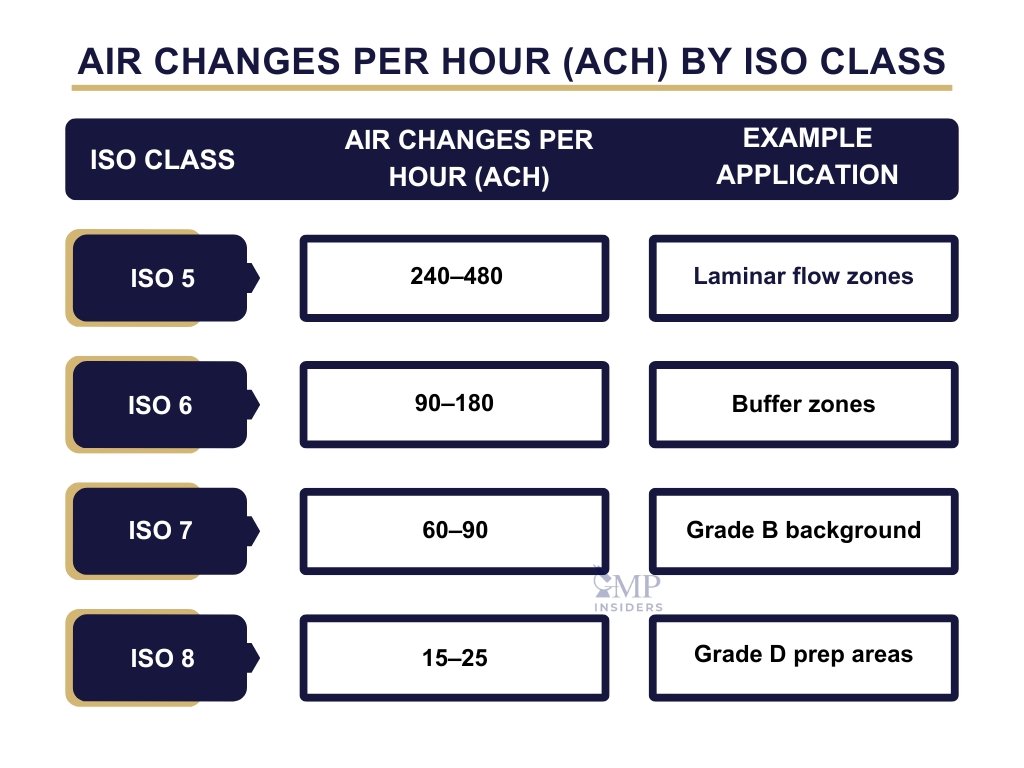
Note: Air change rates can exceed 600 ACH for Grade A laminar airflow zones.
Laminar vs. Turbulent Flow Patterns
Laminar (unidirectional) flow delivers air in a straight path at uniform velocity, minimizing turbulence and carrying particles away from critical zones.
- Required in Grade A environments
- Typical velocity: 0.36–0.54 m/s
Turbulent flow mixes air within the room and is used in lower-grade areas (C/D) where strict unidirectionality is not necessary.
Note: Incorporating proper airflow visualization studies (e.g., smoke studies) ensures airflow patterns are maintained as designed.
Filtration Systems
Cleanroom ventilation systems use high-efficiency filters to control both viable and non-viable particles.
HEPA/ULPA Filter Classification and Integrity Testing
- HEPA (High-Efficiency Particulate Air) filters remove ≥99.97% of particles ≥0.3 µm.
- ULPA (Ultra-Low Penetration Air) filters remove ≥99.9995% of particles ≥0.12 µm.
- Grade A/B zones require 100% filter coverage with regular integrity testing using DOP/PAO aerosol challenge tests (per ISO 14644-3 or EN 1822).
Related Article: Types of HEPA filters used in Pharma Industry
Filter Change Frequency
- Based on differential pressure readings, particle monitoring trends, and manufacturer recommendations
- HEPA filters are typically replaced every 1–3 years or as part of a preventive maintenance program
Pressure Differentials and Room Zoning
An essential element of cleanroom contamination control is the maintenance of proper pressure differentials between classified zones.
Pressure Cascade Concept
Maintaining positive pressure differentials between rooms of different cleanliness prevents contaminated air from entering critical areas.
- Grade A > Grade B > Grade C > Grade D
- Recommended pressure differential: ≥10–15 Pa
Cleanroom Zoning Principles
Cleanrooms must be logically zoned to support personnel and material flows while maintaining cleanliness boundaries.
- Airlocks for personnel and materials
- Separate pathways for “clean” and “dirty” processes
- Unidirectional flow of materials to minimize cross-contamination
Note: Improper zoning is a frequent GMP inspection finding and should be validated during facility design.
SEE ALSO: Contamination vs Cross Contamination vs Mix-ups
Pharmaceutical Cleanroom Materials and Surfaces
Construction materials must support easy cleaning, resist chemical degradation, and avoid particle shedding.
- Wall Panels: Non-porous, smooth, and flush; coated with epoxy or PVC
- Flooring: Seamless, anti-static, and chemically resistant (e.g., PU floors)
- Ceilings: Walkable panels in Grade C/D; sealed grid ceilings in A/B zones
- Furniture: Stainless steel or powder-coated steel; easy to clean and non-shedding
Gowning Requirements by GMP Cleanroom Grades
Personnel are the greatest source of contamination in cleanrooms. Gowning protocols must be tailored to the classification and aligned with Annex 1 expectations.
Table: PPE Required per GMP Cleanroom Grade
| GMP Grade | PPE / Gowning Requirements |
|---|---|
| Grade A | Sterile hood, face mask, goggles, sterile gloves, coverall, sterile boots |
| Grade B | Same as Grade A (full sterile gowning), with additional gowning airlocks |
| Grade C | Hair cover, beard/moustache cover (if applicable), non-sterile gown, dedicated footwear |
| Grade D | Lab coat or dedicated clothing, hair cover, closed cleanroom shoes |
Note: Gowning must be performed in dedicated changing rooms with zoning and step-over barriers to separate clean and unclean areas.
GMP Cleanroom Testing Parameters
Once a cleanroom is built and classified, it must undergo performance tests to verify that it functions within the defined specifications. These tests are crucial for initial qualification (OQ/PQ) and form the basis for routine requalification, trending, and regulatory inspections.
Non-viable particle monitoring using calibrated particle counters is essential for assessing cleanroom compliance with ISO 14644-1 limits and supporting routine environmental monitoring. Cleanroom testing ensures that critical parameters such as airflow, pressure differentials, and contamination containment perform as designed.
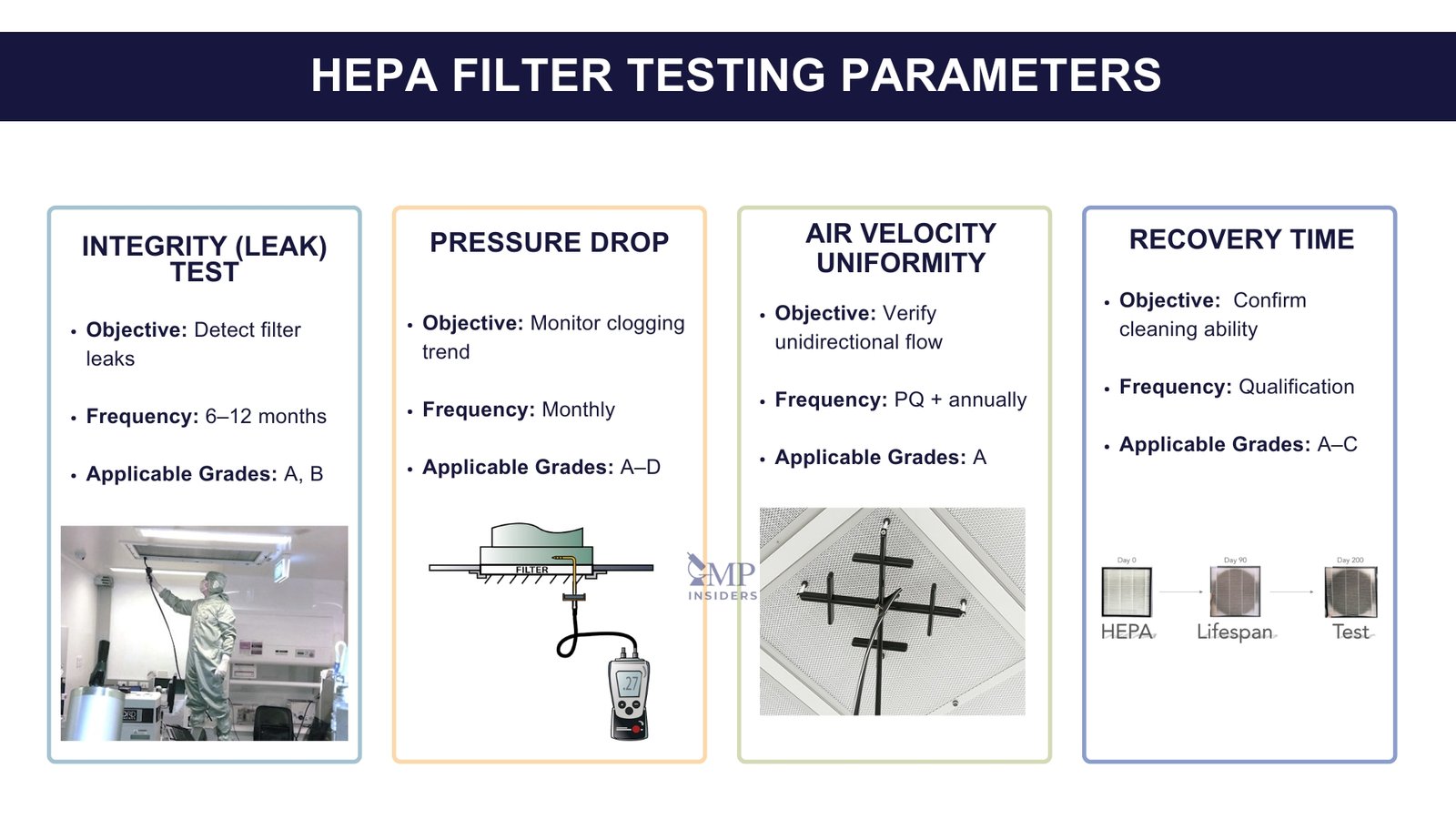
Installed Filter System Leakage and Integrity Testing
Ensuring the integrity of the filtration system is vital to prevent contaminants from entering the cleanroom. This aspect of the qualification process is crucial for ensuring the integrity of the filtration system within the cleanroom.
The filter system is designed to remove particles and contaminants from the air supply. HEPA filter leak test involves assessing whether the filters are properly installed, free of leaks, and capable of effectively trapping particles. This step is essential to prevent contaminants from entering the cleanroom and compromising the sterility of the manufacturing environment.
Tip: Regularly schedule and perform routine checks on filters to detect any potential leaks promptly.
Recommendation: Implement a preventive maintenance program to replace filters as needed and avoid unexpected failures during manufacturing operations.
Airflow Tests – Volume and Velocity
Airflow characteristics play a significant role in maintaining the required air quality within the cleanroom. Volume and velocity tests assess the quantity and speed of air circulation. These tests ensure that the air within the cleanroom is exchanged at the specified rate and that the airflow is uniform.
Proper airflow is crucial for carrying away particles and contaminants and maintaining a controlled environment conducive to sterile product manufacturing.
Tools Used:
- Hot-wire anemometers or vane anemometers (for velocity)
- Flow hoods or balometers (for volumetric flow rate)
Target Specifications:
- Laminar (unidirectional) flow zones: velocity typically between 0.36–0.54 m/s
- Volumetric airflow must meet calculated ACH (Air Changes per Hour) requirements by ISO class
- Velocity should be uniform across HEPA filter face (±20% deviation is acceptable)
Tip: Conduct airflow tests at different locations within the cleanroom to ensure uniformity.
Recommendation: Testing is performed under both “at rest” and “in operation” states for areas classified as Grades A–C.
Air Pressure Difference Test
Maintaining pressure differentials between rooms of differing cleanliness levels prevents cross-contamination and helps control directional airflow. Positive pressure prevents contaminants from entering critical zones.
Directional Control:
- Critical zones (e.g., Grade A) must be positively pressurized relative to adjacent lower-grade areas
- Recommended differential: ≥10–15 Pascals (Pa) between adjacent rooms
Monitoring and Deviations:
- Pressure sensors or magnehelic gauges provide real-time readings
- Deviations may indicate:
- Door leakage
- Filter blockage or fan failure
- Incorrect damper or airlock settings
Tip: Clearly define and document the desired air pressure differentials between cleanroom areas.
Recommendation: Implement real-time monitoring systems to detect and address any deviations in pressure differentials promptly.
Airflow Direction Test and Visualization
Testing airflow direction validates whether the designed air movement patterns are maintained adequately during operation. Visualization confirms that air flows away from critical product and component zones.
Smoke Studies (Airflow Visualization)
- Non-toxic fog (e.g., glycol or polyalphaolefin-based) is released near filters, work surfaces, or potential turbulence points
- Used to:
- Verify unidirectional airflow in Grade A areas
- Identify air turbulence or reverse flow
- Demonstrate protection of critical zones during personnel movement
RELATED ARTICLE: Airflow Visualization Studies in Cleanrooms
Laminar Flow Validation
- Laminar zones must show consistent, sweeping airflow with no backflow or dead zones
- Required in aseptic filling, open vial handling, and media fill simulations
Tip: Use airflow visualization studies to involve personnel in understanding and confirming proper airflow patterns.
Recommendation: Conduct periodic refresher training for cleanroom personnel on the importance of maintaining correct airflow directions.
Microbial Airborne and Surface Contamination
Microbial contamination poses a significant risk in sterile product manufacturing. This part of the qualification process involves monitoring and limiting both airborne and surface microbial contamination.
Air and surface samples are taken and analyzed to ensure that microbial levels are within acceptable limits. This step is essential for maintaining the sterility of the environment and preventing the introduction of microorganisms that could compromise the quality of sterile products.
Tip: Establish a robust environmental monitoring program for continuous microbial surveillance.
Recommendation: Investigate any deviations from acceptable microbial limits promptly and implement corrective actions to address root causes.
Temperature and Relative Humidity Tests
Temperature and relative humidity levels are critical environmental factors in cleanrooms. These tests assess whether the cleanroom maintains the specified temperature and humidity conditions. Consistent control of these factors is essential for the stability of products and the prevention of conditions that could promote microbial growth or compromise product quality.
Tip: Place temperature and humidity sensors strategically across the cleanroom to capture variations in different areas.
Recommendation: Ensure that HVAC systems are calibrated and maintained to control temperature and humidity effectively.
Recovery Time Testing
The recovery test evaluates how quickly a cleanroom returns to its specified particle limits after a contamination event, such as door opening or personnel movement.
Clean-Up Period Definition:
- Time required to reduce airborne particle levels to classification limits after an introduced load
Typical Benchmarks:
- ISO 5 areas: recovery time typically <15 minutes
- Higher ISO classes: longer recovery acceptable, depending on HVAC design
Tip: Simulate potential disruptions during routine operations to assess the cleanroom’s real-world recovery capabilities.
Recommendation: Document and analyze recovery times, and use the data to optimize cleanroom protocols for minimizing downtime.
Containment Leak Test
In facilities handling cytotoxic, allergenic, or highly potent compounds, containment leak tests ensure that air and particles remain confined within designated zones.
Importance:
- Protects both personnel and the environment
- Required in negative-pressure rooms, isolators, and RABS (Restricted Access Barrier Systems)
- Often includes smoke testing and filter integrity verification
SEE ALSO: RABS vs Isolators
Tip: Regularly review and update containment systems based on technological advancements and lessons learned from past incidents.
Recommendation: Conduct thorough training for personnel on the proper use and maintenance of containment equipment to minimize the risk of leaks.
Cleanroom Classification Comparisons: Annex 1, ISO, and US Standards
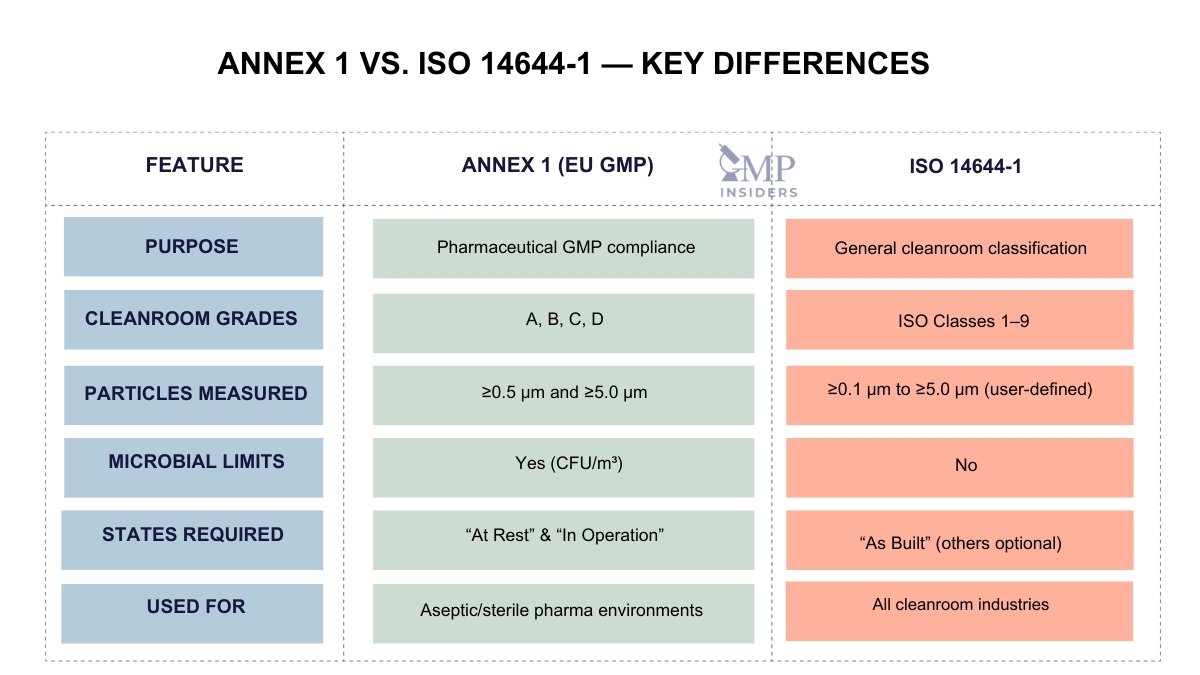
To ensure global harmonization and consistency, cleanroom classifications in GMP guidelines often align with international standards such as ISO and US Federal Standards. Let’s compare cleanroom classifications according to Annex 1, ISO, and US standards:
Annex 1 Cleanroom Classifications
The EU GMP Annex 1 cleanroom grades—A through D—provide a structured approach to controlling contamination based on process criticality, with clear distinctions in particle and microbial limits.
It aligns with ISO 14644-1:2015 for cleanroom classifications. The grades and their associated ISO equivalents are as follows:
- Grade A: ISO Class 5 at rest and in operation
- Grade B: ISO Class 5 at rest, ISO Class 7 in operation
- Grade C: ISO Class 7 at rest, ISO Class 8 in operation
- Grade D: ISO Class 8 at rest and in operation
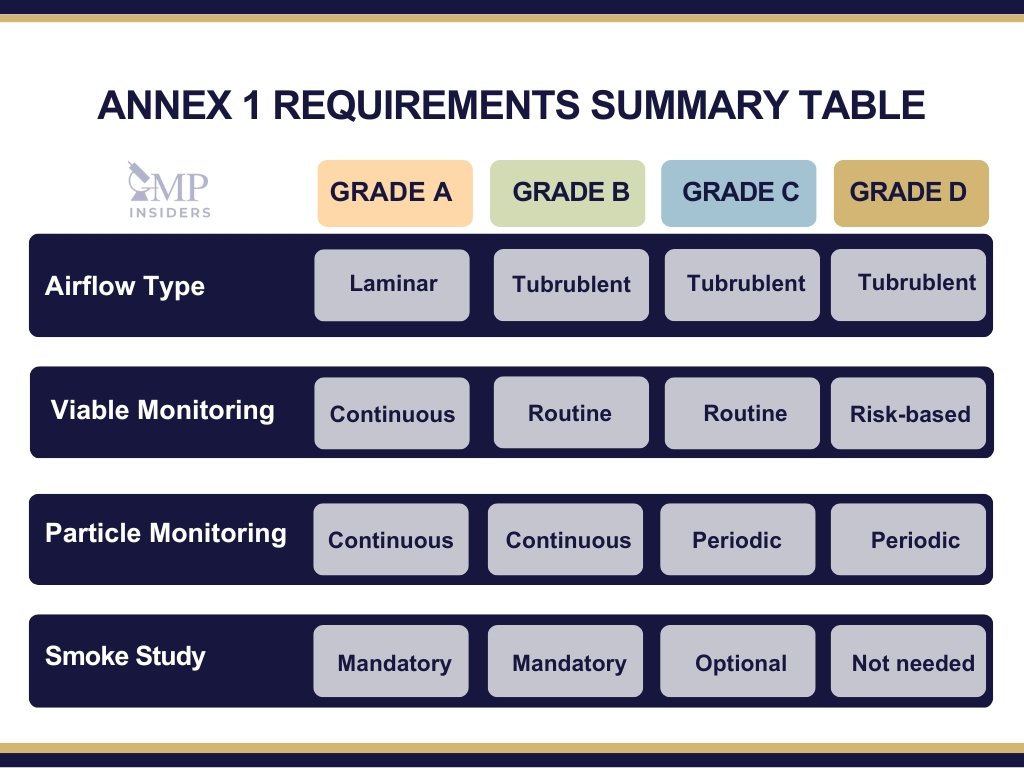
ISO Cleanroom Classifications
ISO 14644-1:2015 provides a comprehensive classification system for cleanrooms. The classifications are based on the maximum permitted concentration of airborne particles.
| ISO Class | Maximum Particles/m³ | ||||||||||||
|---|---|---|---|---|---|---|---|---|---|---|---|---|---|
| ISO 1 | 10 | ||||||||||||
| ISO 2 | 100 | ||||||||||||
| ISO 3 | 1,000 | ||||||||||||
| ISO 4 | 10,000 | ||||||||||||
| ISO 5 | 100,000 | ||||||||||||
| ISO 6 | 1,000,000 | ||||||||||||
| Class | Maximum Particles/ft³ |
|---|---|
| Class 1 | 35 |
| Class 10 | 350 |
| Class 100 | 3,500 |
| Class 1,000 | 35,000 |
| Class 10,000 | 350,000 |
| Class 100,000 | 3,500,000 |
Note: FED-STD-209E was officially withdrawn in 2001 but is still widely referenced. It uses particle concentration per cubic foot, unlike ISO 14644 which measures per cubic meter.
Cleanroom Qualification and Validation Process
Qualification and validation are essential for demonstrating that a cleanroom consistently performs as intended, supports product quality, and complies with GMP and ISO 14644-1 requirements.
These activities provide documented evidence that the cleanroom environment can reliably meet its classification parameters under defined conditions, both for non-viable particle control and microbiological limits.
Documented cleanroom validation protocols must define the sequence of qualification activities (DQ, IQ, OQ, PQ) and be aligned with regulatory expectations and product-specific contamination risks.
Stages of Cleanroom Qualification
Cleanroom qualification is typically performed in four stages, each building upon the last to ensure facility readiness and operational reliability.
Design Qualification (DQ)
- Verifies that the cleanroom design meets all regulatory, functional, and process requirements.
- Includes layout drawings, zoning strategy, airflow direction, HVAC specifications, pressure differentials, and material/personnel flow.
- Must consider Annex 1, ISO 14644, and product-specific contamination risks.
Installation Qualification (IQ)
- Confirms that all cleanroom components—HVAC systems, filters, sensors, control panels—are installed correctly and in accordance with design specifications.
- Includes verification of:
- HEPA/ULPA filter placement and labeling
- HVAC installation parameters
- Construction material compliance (surfaces, panels, flooring)
Operational Qualification (OQ)
- It should include all critical ISO 14644-3 validation tests, such as airflow volume and velocity measurements, and aerosol challenge testing for filter integrity.
- Tests the functionality of cleanroom systems under static conditions (i.e., “at rest” state).
- Key OQ tests include:
- Airflow volume and velocity testing
- HEPA filter integrity (leak) testing
- Pressure differential mapping
- Airflow direction and visualization (smoke study)
- Temperature and relative humidity monitoring
- Recovery time testing
- Lighting and noise levels (where applicable)
- Airflow volume and velocity testing
Performance Qualification (PQ)
- Conducted under “in operation” conditions to confirm that the cleanroom performs as expected during actual manufacturing activities.
- Includes:
- Microbial monitoring (air and surface)
- Non-viable particle count testing
- Personnel and equipment challenge studies
- PQ is usually linked to media fill validation in aseptic manufacturing environments.
READ MORE: Cleanroom Qualification and Validation in GMP
FAQ
Can Cleanroom Classification Limits Be Customized Based on Specific Manufacturing Processes?
Cleanroom classification limits are generally standardized based on industry standards and regulations. However, in some cases, limits may be adjusted based on a thorough risk assessment and scientific justification, considering the specific needs of the manufacturing processes.
Can a Cleanroom Be Reclassified After a Process Change?
Yes. Any significant change to the process, room layout, or airflow dynamics may require reclassification. A documented risk assessment should be performed to determine whether requalification and reclassification are necessary.
Are All ISO Classes Applicable to Pharmaceutical Cleanrooms?
No. In practice, ISO Classes 5 to 8 are used in pharmaceutical manufacturing. ISO Classes 1–4 are more relevant to industries like nanotechnology or semiconductor manufacturing, where ultra-clean environments are required.
Can One Cleanroom Be Used for Multiple Grades?
No. A single room cannot operate simultaneously under different GMP grades. However, zoning within larger areas or the use of closed isolators/RABS can allow different classified operations to occur within a shared environment, if validated and controlled.
How Often Should Cleanrooms and Clean Air Equipment Be Requalified?
The frequency of requalification depends on the cleanroom grade. Grade A and B areas should be requalified every six months, while Grade C and D areas require requalification every 12 months. Requalification is also necessary after changes, remedial actions, or as determined by risk assessments.
What Is the Significance of the “Clean Up” Period in Cleanroom Classification?
The “clean up” period is when restoring the cleanroom to its qualified state after manufacturing operations. It is crucial for maintaining consistent cleanliness levels and preventing the persistence of contaminants introduced during operations.
Conclusion
Cleanroom classifications play a critical role in maintaining pharmaceutical products’ safety, purity, and quality. A clear understanding of the differences between GMP Grades A to D, their ISO 14644-1 equivalents, practical applications, and environmental monitoring requirements is essential for achieving and sustaining regulatory compliance.
By aligning with GMP expectations and implementing robust systems for cleanroom design, qualification, monitoring, and auditing, pharmaceutical manufacturers can establish controlled environments that effectively reduce the risk of contamination and support consistent product quality.
As cleanroom technologies advance and international standards harmonize, staying current with evolving regulatory guidance, such as Annex 1, ISO 14644, and FDA recommendations, is essential. A proactive approach to cleanroom control enhances inspection readiness and reinforces a manufacturer’s commitment to patient safety and operational excellence.
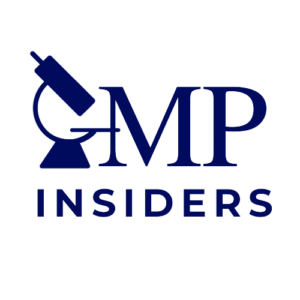
Subscribe to our Newsletter
Sign up to recieve latest news, GMP trends and insights from our industry experts




